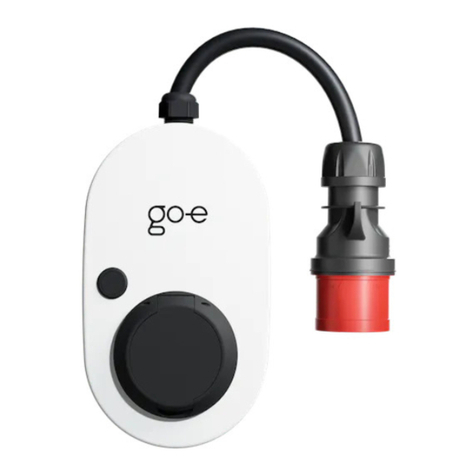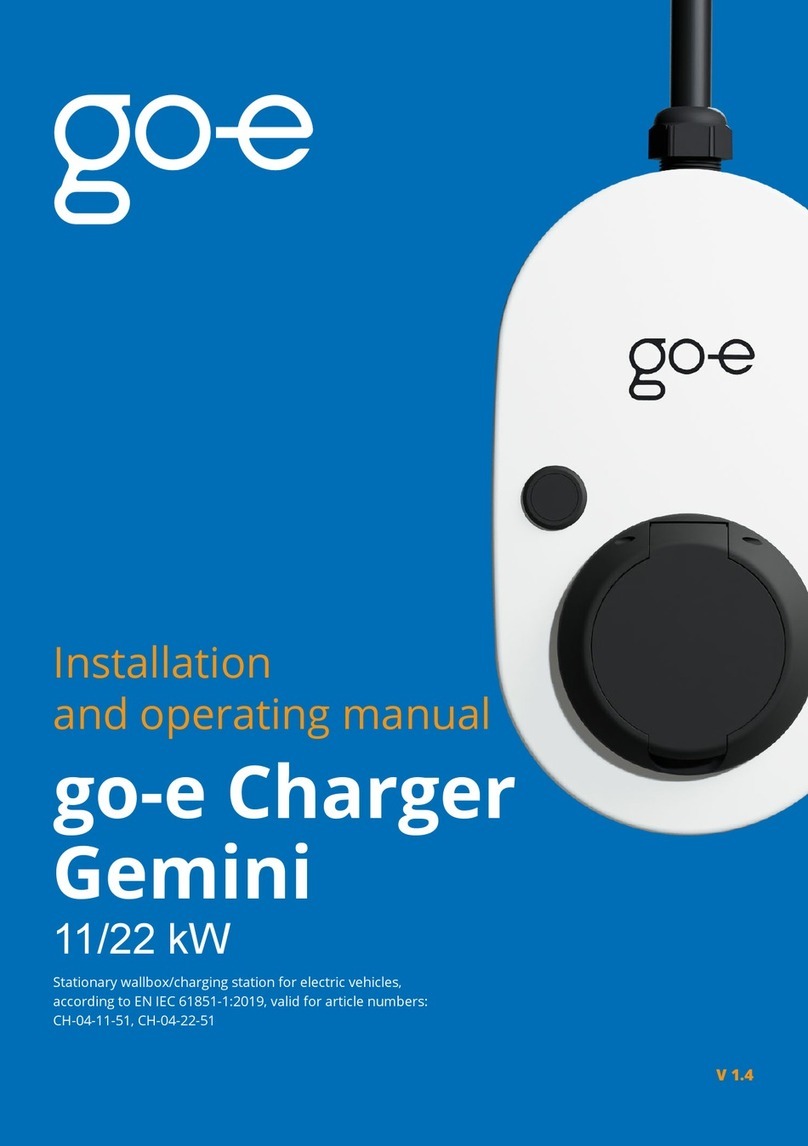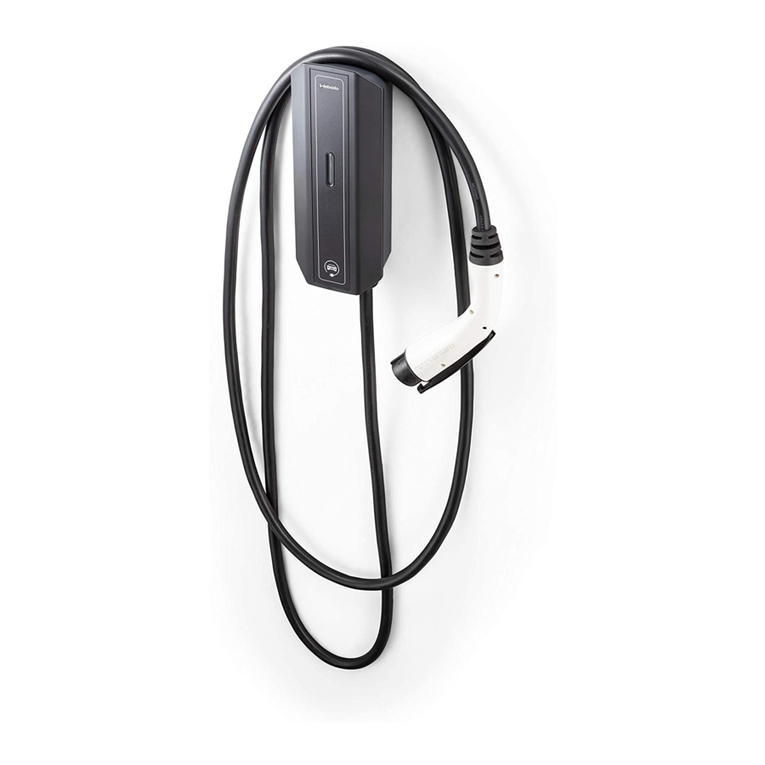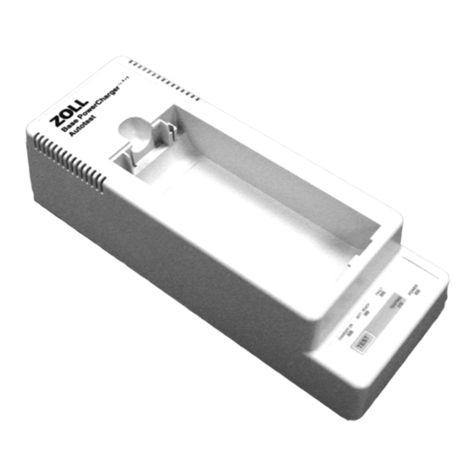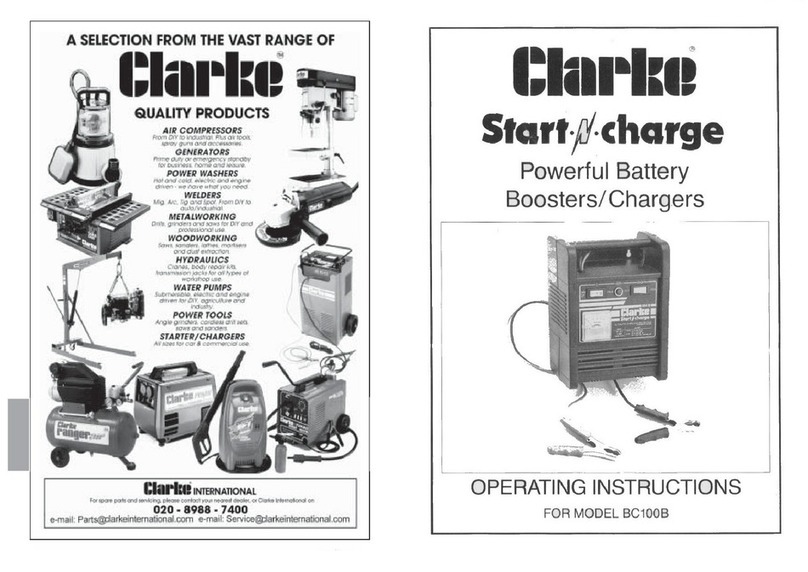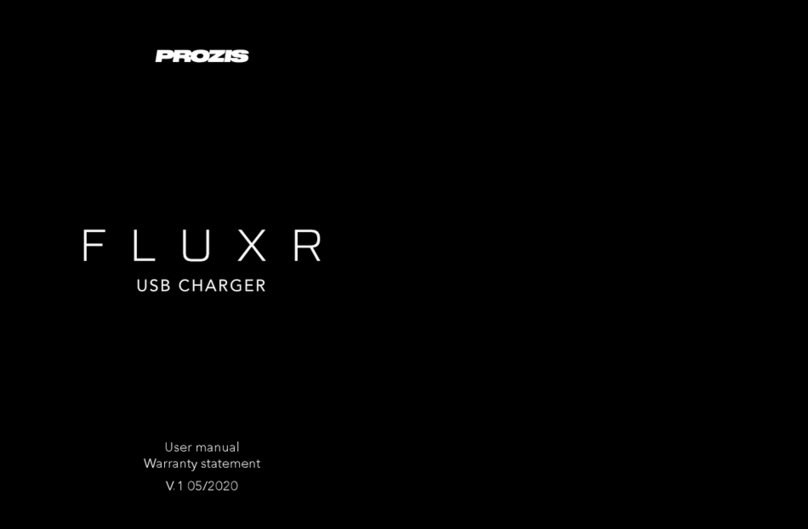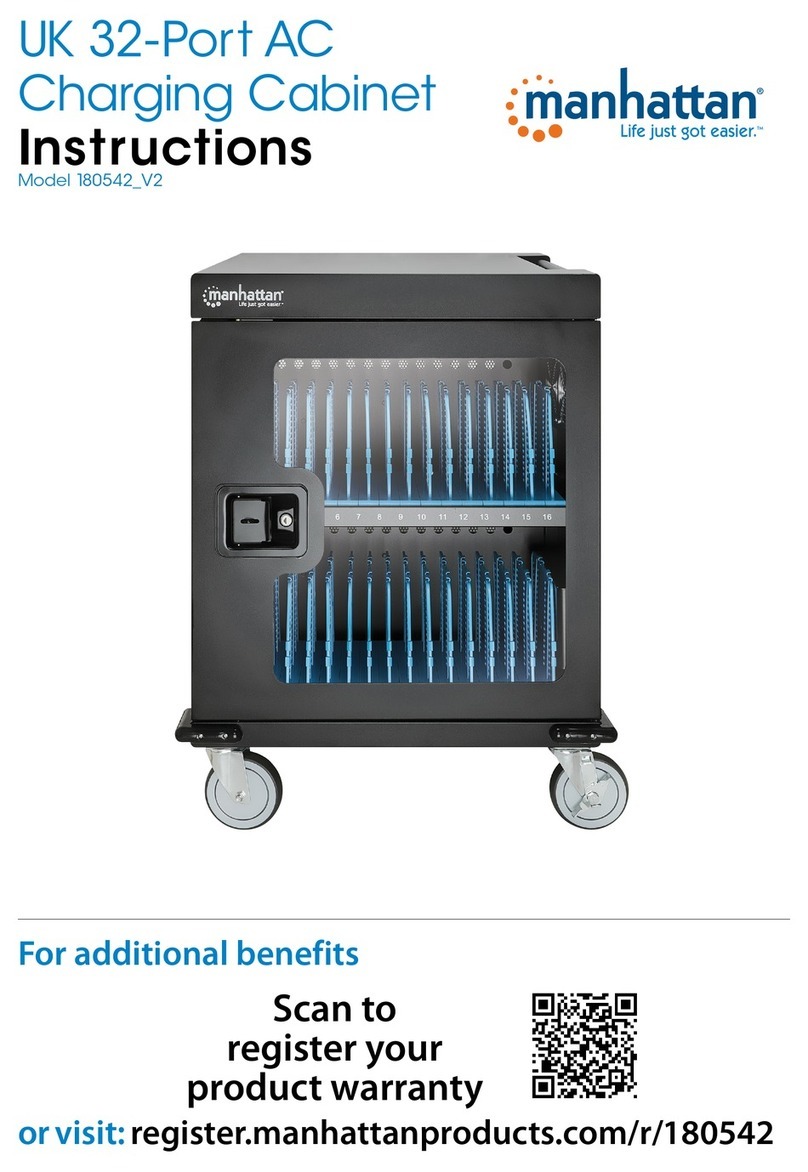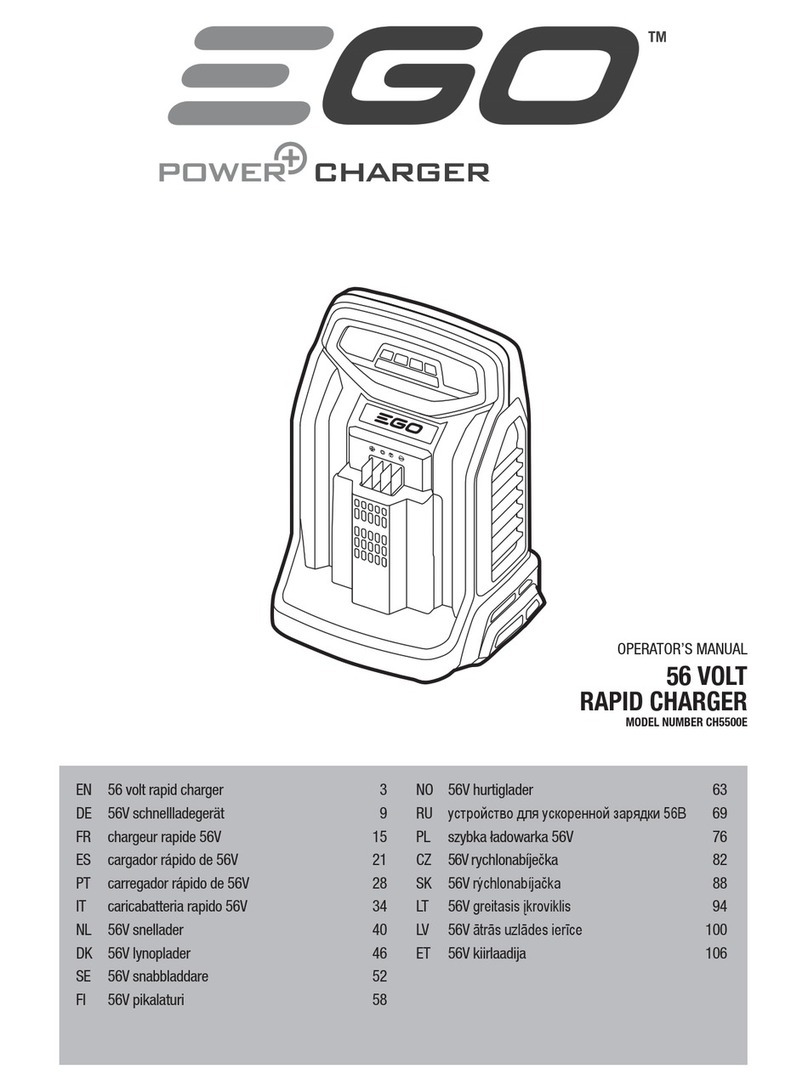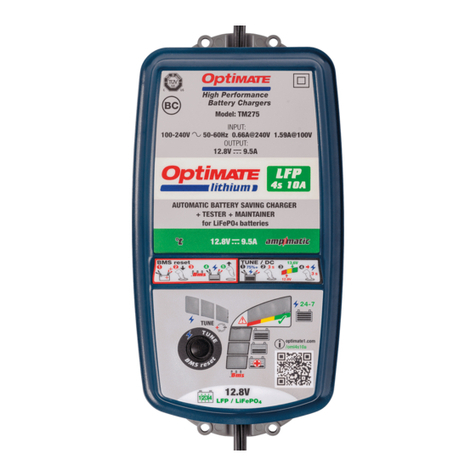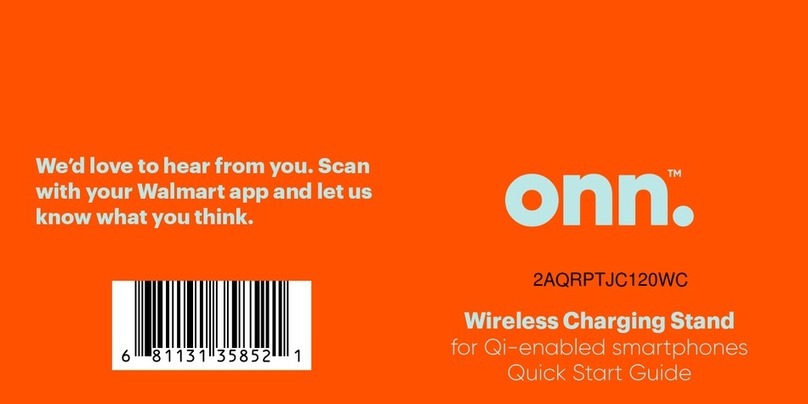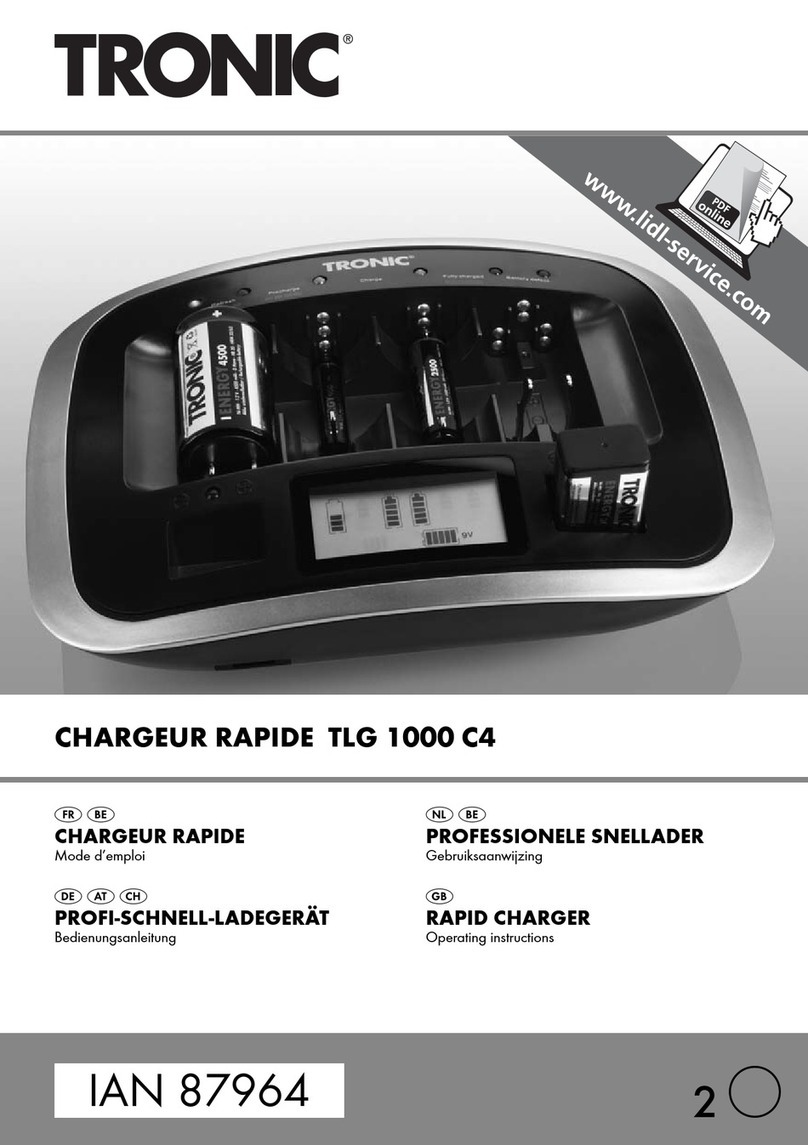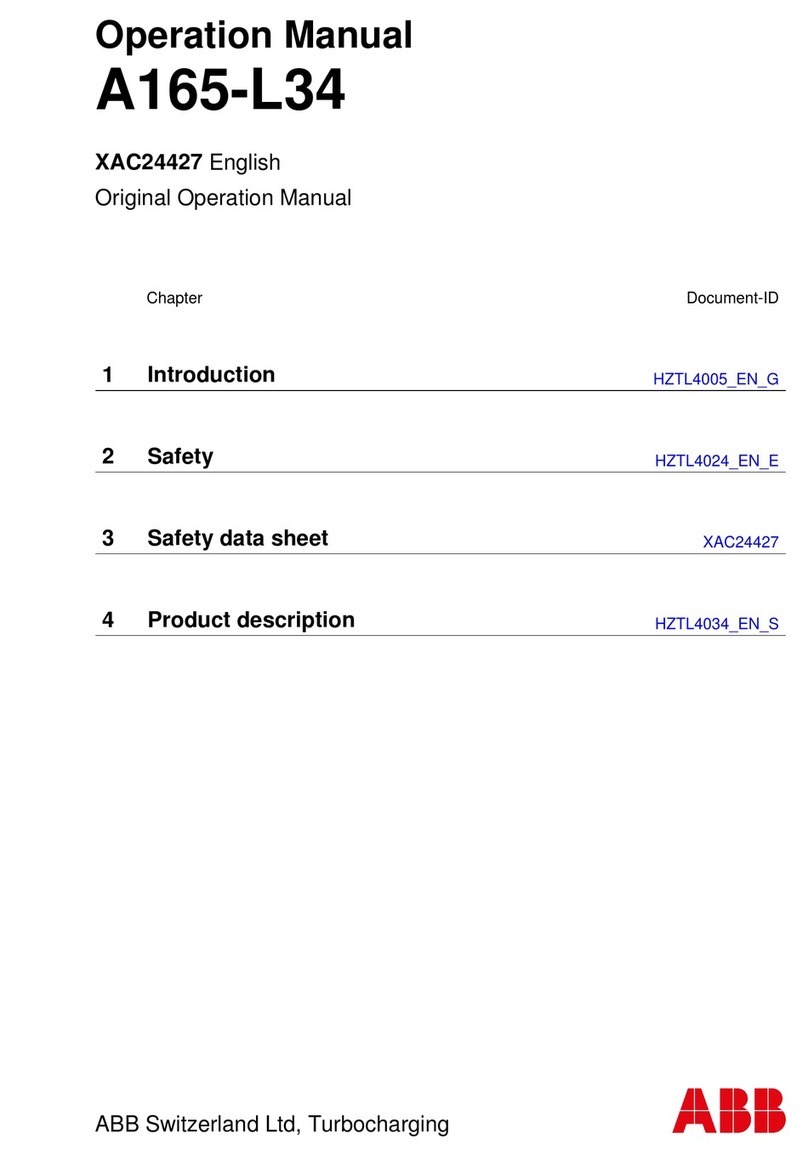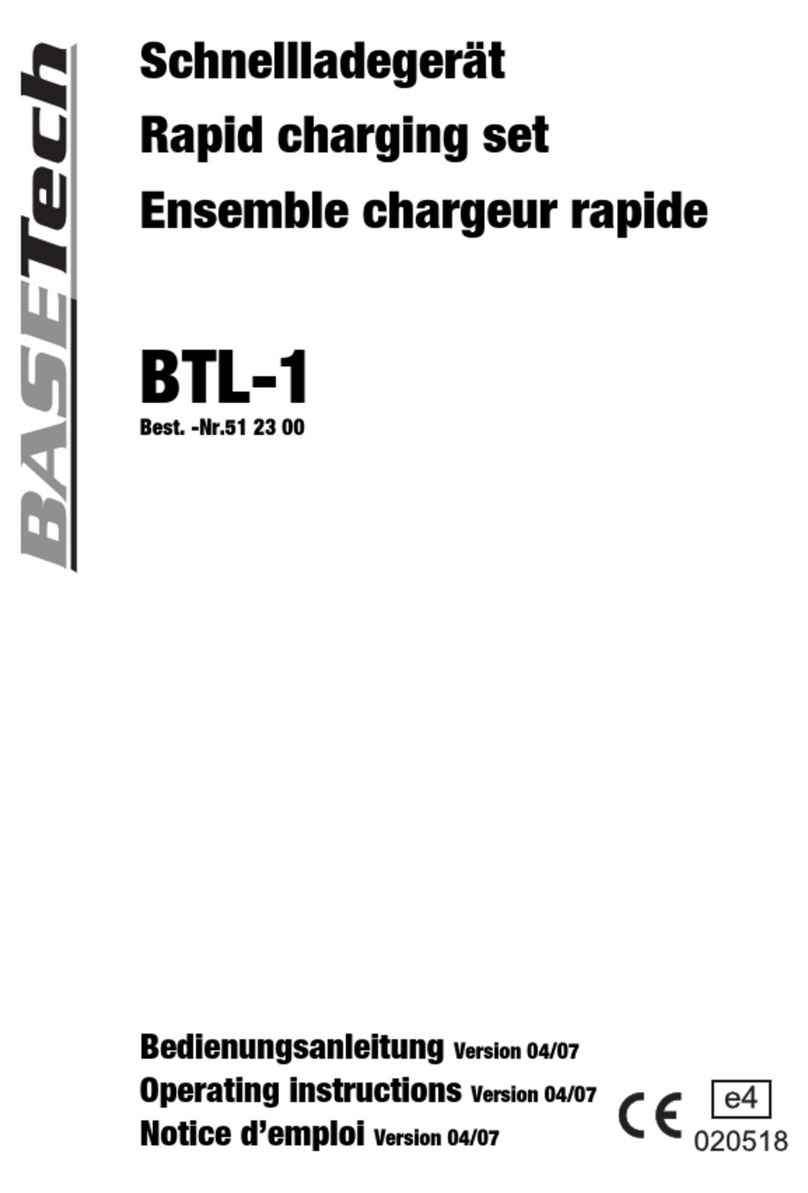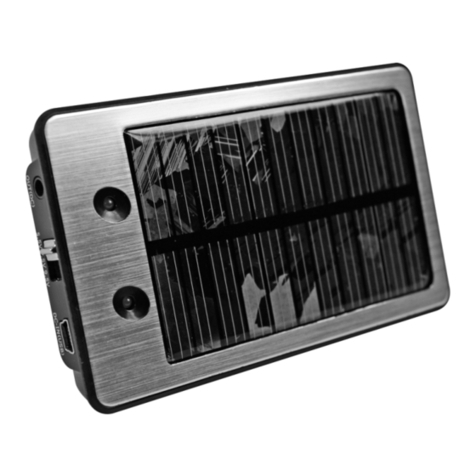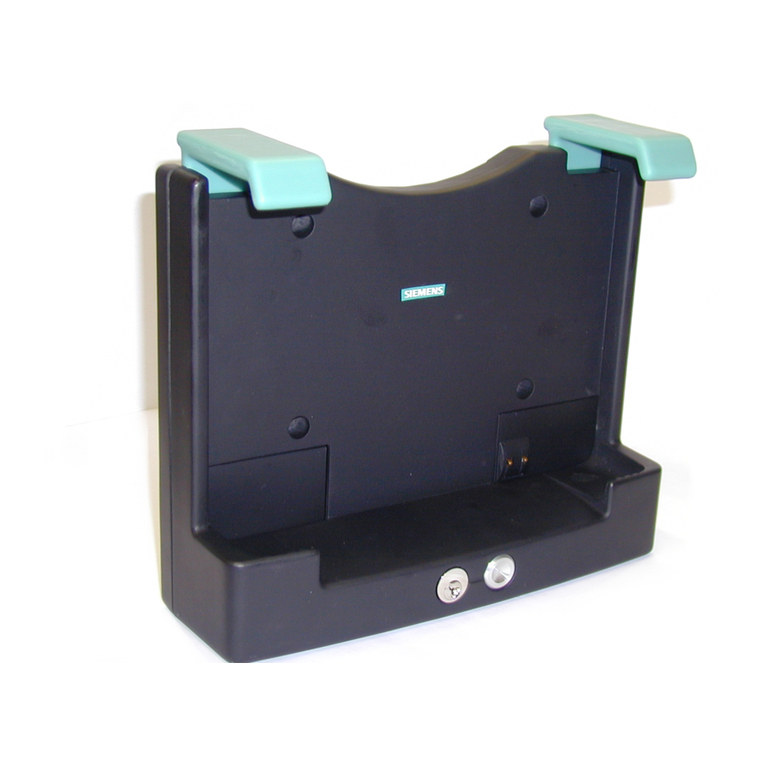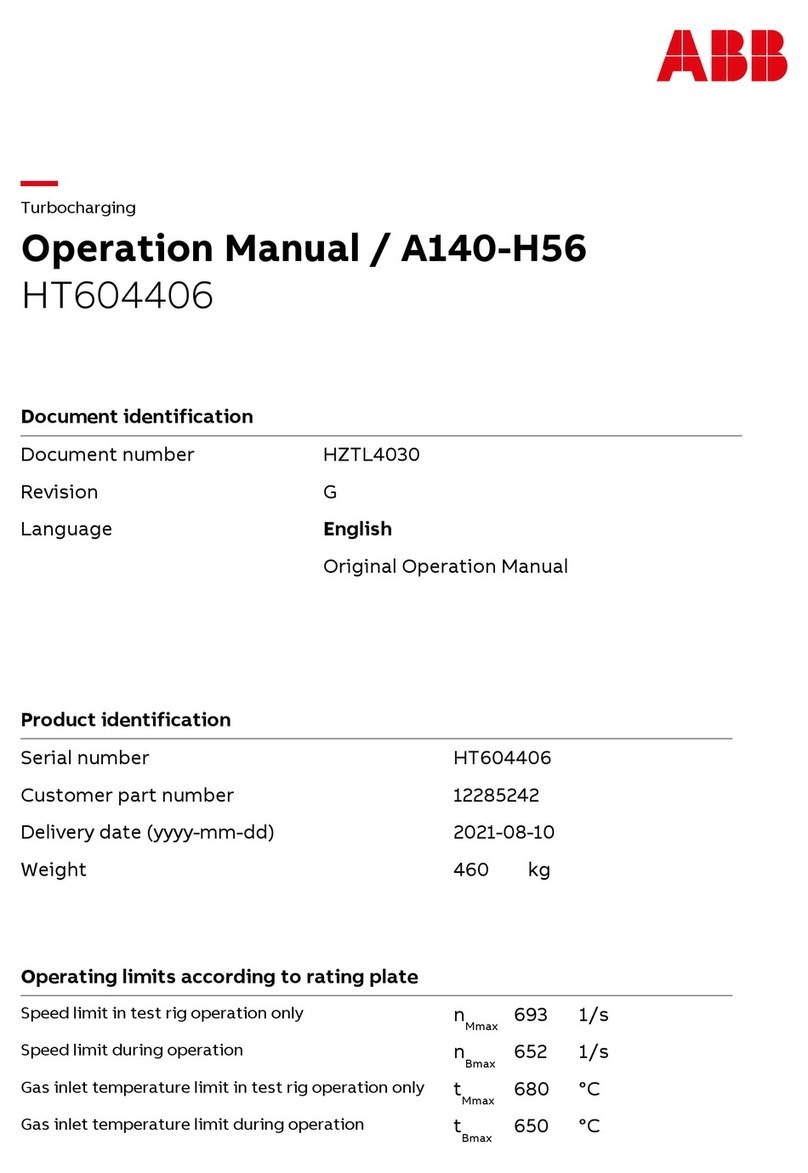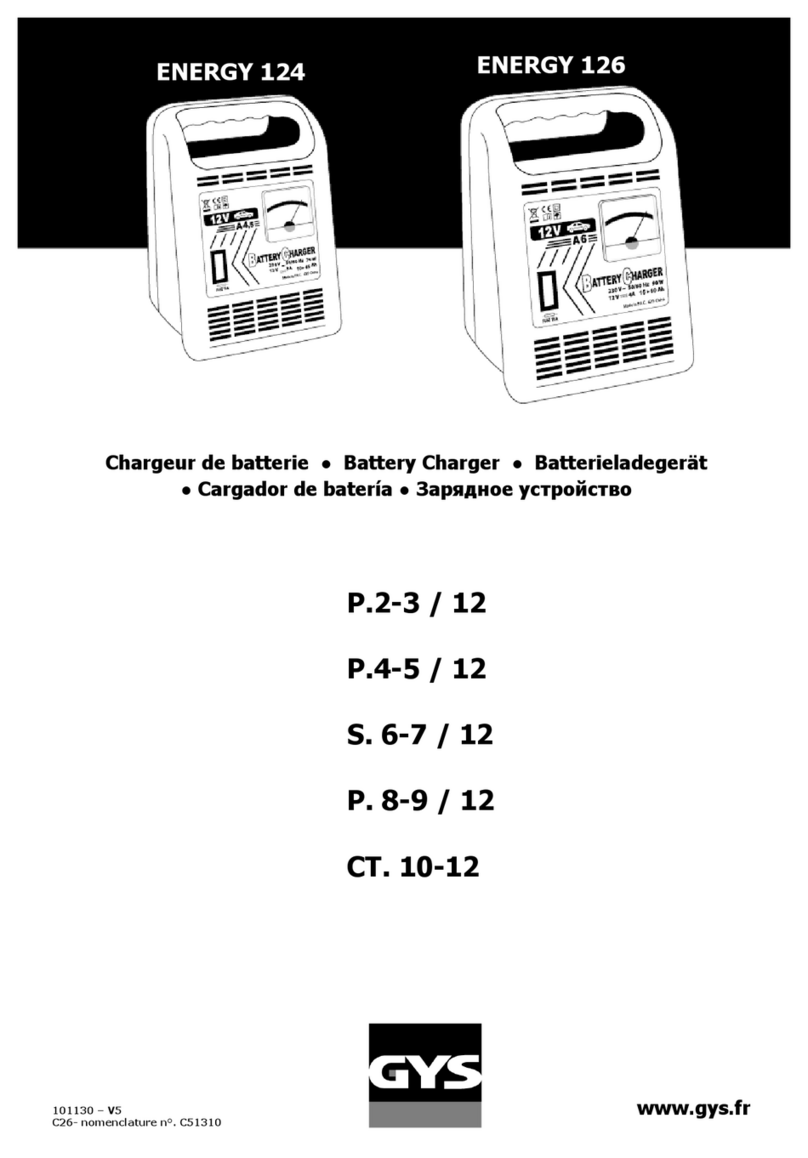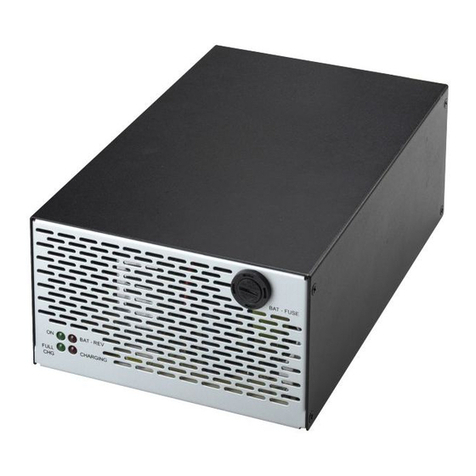go-e Charger HOME+ User manual

Operating instructions
for the product variants 11 kW and 22 kW

Copyright by go-e GmbH.
The content of this document may not be copied partly or published or circulated in
any form other than that approved by go-e GmbH without the written permission of
go-e GmbH.
Page 2
Thank you for your purchase decision
With the go-eCharger HOME+ you have chosen a solid, extremely
compact and versatile product.
The Charger has been developed for extreme flexibility, offers you
the advantages of a conventional wallbox and the possibility to
charge anywhere where there is alternating current and three-
phase current, provided that you have the appropriate socket
adapter.
With the go-eCharger HOME+ you have chosen a fully equipped
charging box. Because smart and intelligent solutions that make
charging electric vehicles even more convenient are already
integrated in the go-eCharger HOME+.
The go-eCharger was developed and tested by electric car drivers
for electric car drivers. To keep it up to date in the future, we are
constantly developing the firmware and adapting it to the state of
the art. So let us surprise you with future features.
We wish you much pleasure with your great product and always
enough electricity.
Your go-e team
Page 3

Copyright by go-e GmbH.
The content of this document may not be copied partly or published or circulated in
any form other than that approved by go-e GmbH without the written permission of
go-e GmbH.
Page 2
Thank you for your purchase decision
With the go-eCharger HOME+ you have chosen a solid, extremely
compact and versatile product.
The Charger has been developed for extreme flexibility, offers you
the advantages of a conventional wallbox and the possibility to
charge anywhere where there is alternating current and three-
phase current, provided that you have the appropriate socket
adapter.
With the go-eCharger HOME+ you have chosen a fully equipped
charging box. Because smart and intelligent solutions that make
charging electric vehicles even more convenient are already
integrated in the go-eCharger HOME+.
The go-eCharger was developed and tested by electric car drivers
for electric car drivers. To keep it up to date in the future, we are
constantly developing the firmware and adapting it to the state of
the art. So let us surprise you with future features.
We wish you much pleasure with your great product and always
enough electricity.
Your go-e team
Page 3

Preface
Drivers of electric vehicles consciously choose this type of mobility. Electric
drives are quiet and do not emit any environmentally harmful gases. But electric
vehicles also need energy, which must be generated.
We are surrounded by energy. Every degree Celsius above absolute zero is
energy. If we use existing energy carefully, we do not need to expand fossil
power plants or nuclear power plants for electric mobility.
An important contribution we can all make is the use of surplus energy. If
possible, do not charge your car when you come home after work, as the
electricity grid is already the most heavily charged. In order to save energy and
charge in an environmentally friendly manner, you should transfer your
charging processes to lunchtime or early in the morning, as there is an
abundance of electricity in the networks during this time.
This becomes even more interesting with a contract with our partner aWATTar,
where you can profit from the strongly fluctuating electricity prices on the
electricity price exchange by purchasing the electricity when the electricity is
the cheapest. The technology for this is already built into each of our charging
boxes. For more information, please visit
https://www.awattar.com/services/goe
go-e will continue to work on making its products more energy-efficient and
environmentally friendly in the future for a major goal: a future without
emissions.
Frank Fox
(founder go-e GmbH)
Page 4
Table of Contents
Prelude Page 6
Registration information Page 6
Operating instructions Page 7
Product overview Page 9
Scope of delivery Page 10
Technical specifications Page 11
Mounting Page 12
Commissioning Page 13
Error indication Page 14
The app Page 15
WiFi settings Page 20
WiFi wizard Page 22
Troubleshooting: What does the
colours of the LED ring mean? Page 23
Warranty Page 24
Confirmation for subsidy Page 25
CE declaration of conformity Page 26
Contact details Page 27
Page 5

Preface
Drivers of electric vehicles consciously choose this type of mobility. Electric
drives are quiet and do not emit any environmentally harmful gases. But electric
vehicles also need energy, which must be generated.
We are surrounded by energy. Every degree Celsius above absolute zero is
energy. If we use existing energy carefully, we do not need to expand fossil
power plants or nuclear power plants for electric mobility.
An important contribution we can all make is the use of surplus energy. If
possible, do not charge your car when you come home after work, as the
electricity grid is already the most heavily charged. In order to save energy and
charge in an environmentally friendly manner, you should transfer your
charging processes to lunchtime or early in the morning, as there is an
abundance of electricity in the networks during this time.
This becomes even more interesting with a contract with our partner aWATTar,
where you can profit from the strongly fluctuating electricity prices on the
electricity price exchange by purchasing the electricity when the electricity is
the cheapest. The technology for this is already built into each of our charging
boxes. For more information, please visit
https://www.awattar.com/services/goe
go-e will continue to work on making its products more energy-efficient and
environmentally friendly in the future for a major goal: a future without
emissions.
Frank Fox
(founder go-e GmbH)
Page 4
Table of Contents
Prelude Page 6
Registration information Page 6
Operating instructions Page 7
Product overview Page 9
Scope of delivery Page 10
Technical specifications Page 11
Mounting Page 12
Commissioning Page 13
Error indication Page 14
The app Page 15
WiFi settings Page 20
WiFi wizard Page 22
Troubleshooting: What does the
colours of the LED ring mean? Page 23
Warranty Page 24
Confirmation for subsidy Page 25
CE declaration of conformity Page 26
Contact details Page 27
Page 5

Page 6 Page 7
Registration information:
Depending on the country, the requirements of the authorities and electricity
network operators have to be observed, such as a reporting or approval
requirement for charging equipment, or the limitation of 1-phase charging.
Please contact your network operator to find out whether the go-eCharger is
subject to registration or approval and whether other restrictions must be
observed.
Note for Germany: Most of the relevant regulations can be found in the TAR Low
Voltage (VDE-AR-N 4100:2019-04). According to this, every charging station
from 3.6 kW has to be registered at the responsible electricity network operator
according to his specifications before you put it into operation. Up to 12 kW
charging power (like the go-eCharger HOME+ 11 kW), you only need to inform
the operator where you use the charging box. You can then immediately start
charging your vehicle.
If the charging station has a power output of more than 12 kW (like the go-
eCharger HOME+ 22 kW), you have to wait for the approval of the German
network operator after registration and before installation. Based on research
by go-e, the approval is almost always granted. Sometimes a reinforcement of
the house connection is necessary for this. Further information on registration
and approval can be found on our website at https://go-e.co/products/go-
echarger-home/?lang=en in the FAQ.
Please read the instructions for the unit carefully before installa-
tion and initial operation and observe all safety instructions!
This manual should help you:
Ÿto use the product properly
Ÿto avoid damage
Ÿto increase durability and reliability
Ÿto prevent a hazard
go-e GmbH does not assume any liability for damages
caused by disregarding these instructions!
Prelude Safety Instructions
Non-compliance with the operating instructions can have serious
consequences. go-e GmbH does not assume any liability for damage
caused by disregarding operating instructions or other warnings on the
device itself.
Attention! High voltage, fire hazard! Never use the device if the housing is
damaged or opened!
Do not use the go-eCharger if the cables attached or connected to the
device are damaged.
Never use wet or dirty plugs in conjunction with the go-eCharger.
Make sure that the connection to which the go-eCharger is to be connected
has been properly installed and is undamaged.
The go-eCharger has a built-in RCD protection device with DC current
detection (30 mA AC and 6 mA DC). Therefore an upstream RCD type B is
not necessary. The circuit (socket) to which the go-eCharger is connected
has to be independently of this fitted with an RCD type A and circuit
breaker.
Any modification or repair of hardware or software may only be carried out
by qualified personnel of go-e GmbH or personnel trained for this purpose.
The removal of warnings attached to the go-eCharger or the opening of the
device will result in the loss of any liability by go-e GmbH.
The go-eCharger may only be used for the purpose of charging EV
batteries in conjunction with the appropriate adapters and cables.
It‘s important to observe the maximum permissible charging current of the
connection at which you are charging. If you don't known this, charge with
the lowest charge current. When using adapters, the maximum current for
the adapter has to be observed. If this is not known, use the lowest
charging current. Attention: The go-eCharger HOME+ 22 kW automatically
reduces the charging current to 16 A by plugging in the adapter only in
conjunction with the original go-e adapters. The go-eCharger HOME+ 11
kW always charges with a maximum of 16 A, regardless of the adapter.
Never use adapters whose technical suitability is unclear!
Never unplug by pulling the cable.
We recommend a maximum charging current of 10A for use with domestic
plugs. Take care of a mechanical relief of the domestic plug by supporting
the weight of the go-eCharger and the connected charging cable!
Observe the specifications of the electricity network operator with regard to
single-phase charging and the resulting asymmetrical grid load.
WARNING
ATTENTION
WARNING
ATTENTION

Page 6 Page 7
Registration information:
Depending on the country, the requirements of the authorities and electricity
network operators have to be observed, such as a reporting or approval
requirement for charging equipment, or the limitation of 1-phase charging.
Please contact your network operator to find out whether the go-eCharger is
subject to registration or approval and whether other restrictions must be
observed.
Note for Germany: Most of the relevant regulations can be found in the TAR Low
Voltage (VDE-AR-N 4100:2019-04). According to this, every charging station
from 3.6 kW has to be registered at the responsible electricity network operator
according to his specifications before you put it into operation. Up to 12 kW
charging power (like the go-eCharger HOME+ 11 kW), you only need to inform
the operator where you use the charging box. You can then immediately start
charging your vehicle.
If the charging station has a power output of more than 12 kW (like the go-
eCharger HOME+ 22 kW), you have to wait for the approval of the German
network operator after registration and before installation. Based on research
by go-e, the approval is almost always granted. Sometimes a reinforcement of
the house connection is necessary for this. Further information on registration
and approval can be found on our website at https://go-e.co/products/go-
echarger-home/?lang=en in the FAQ.
Please read the instructions for the unit carefully before installa-
tion and initial operation and observe all safety instructions!
This manual should help you:
Ÿto use the product properly
Ÿto avoid damage
Ÿto increase durability and reliability
Ÿto prevent a hazard
go-e GmbH does not assume any liability for damages
caused by disregarding these instructions!
Prelude Safety Instructions
Non-compliance with the operating instructions can have serious
consequences. go-e GmbH does not assume any liability for damage
caused by disregarding operating instructions or other warnings on the
device itself.
Attention! High voltage, fire hazard! Never use the device if the housing is
damaged or opened!
Do not use the go-eCharger if the cables attached or connected to the
device are damaged.
Never use wet or dirty plugs in conjunction with the go-eCharger.
Make sure that the connection to which the go-eCharger is to be connected
has been properly installed and is undamaged.
The go-eCharger has a built-in RCD protection device with DC current
detection (30 mA AC and 6 mA DC). Therefore an upstream RCD type B is
not necessary. The circuit (socket) to which the go-eCharger is connected
has to be independently of this fitted with an RCD type A and circuit
breaker.
Any modification or repair of hardware or software may only be carried out
by qualified personnel of go-e GmbH or personnel trained for this purpose.
The removal of warnings attached to the go-eCharger or the opening of the
device will result in the loss of any liability by go-e GmbH.
The go-eCharger may only be used for the purpose of charging EV
batteries in conjunction with the appropriate adapters and cables.
It‘s important to observe the maximum permissible charging current of the
connection at which you are charging. If you don't known this, charge with
the lowest charge current. When using adapters, the maximum current for
the adapter has to be observed. If this is not known, use the lowest
charging current. Attention: The go-eCharger HOME+ 22 kW automatically
reduces the charging current to 16 A by plugging in the adapter only in
conjunction with the original go-e adapters. The go-eCharger HOME+ 11
kW always charges with a maximum of 16 A, regardless of the adapter.
Never use adapters whose technical suitability is unclear!
Never unplug by pulling the cable.
We recommend a maximum charging current of 10A for use with domestic
plugs. Take care of a mechanical relief of the domestic plug by supporting
the weight of the go-eCharger and the connected charging cable!
Observe the specifications of the electricity network operator with regard to
single-phase charging and the resulting asymmetrical grid load.
WARNING
ATTENTION
WARNING
ATTENTION

Page 8
(2) Connection cable
(7) LED ring
(5) Button
(4) Housing
(6) Typ 2 socket
Page 9
(8) Fine-wire fuse on the back
Product overview
(3) Strain relief
32 A CEE Plug (HOME+ 22 kW)
16 A CEE Plug (HOME+ 11 kW)
(1)
Never cover the go-eCharger during charging. Heat accumulation can lead
to permanent damage or even fire.
In the event of unusual heat generation, the charging process has to be
stopped immediately.
If you notice discoloration or deformation of the plastic due to heat
generation, it is imperative that you contact the customer service.
Use your go-eCharger exclusively hanging or in the wall mount. Never use
the charging box lying down! The type 2 connectors are not waterproof and
water could penetrate to the contacts while lying down!
The go-eCharger is suitable for charging gassing vehicle traction batteries
only in well ventilated rooms. In case of uncertainty, please contact your
vehicle manufacturer.
The go-eCharger HOME+ 11 kW may only be operated on the
following connections:
¡CEE red 16 A 3-phase 400 V 50 Hz
With go-eCharger adapter for HOME+ 11 kW:
¡CEE red 32 A 3-phase 400 V 50 Hz (limited by Charger to 16 A 3-phase)
¡CEE blue 16 A 1-phase 230 V 50 Hz
¡multiple domestic plugs 16 A 1-phase 230 V 50 Hz
The go-eCharger HOME+ 22 kW may only be operated on the
following connections:
¡CEE red 32 A 3-phase 400 V 50 Hz
With go-eCharger adapter for HOME+ 22 kW:
¡CEE red 16 A 3-phase 400 V 50 Hz
¡CEE blue 16 A 1-phase 230 V 50 Hz
¡CEE blue 32 A 1-phase 230 V 50 Hz
¡multiple domestic plugs 16 A 1-phase 230 V 50 Hz
The original go-e adapters for the go-eCharger HOME+ 11 kW and go-
eCharger HOME+ 22 kW may only be used in conjunction with the
respective go-eCharger.
Safety Instructions
WARNING
ATTENTION

Page 8
(2) Connection cable
(7) LED ring
(5) Button
(4) Housing
(6) Typ 2 socket
Page 9
(8) Fine-wire fuse on the back
Product overview
(3) Strain relief
32 A CEE Plug (HOME+ 22 kW)
16 A CEE Plug (HOME+ 11 kW)
(1)
Never cover the go-eCharger during charging. Heat accumulation can lead
to permanent damage or even fire.
In the event of unusual heat generation, the charging process has to be
stopped immediately.
If you notice discoloration or deformation of the plastic due to heat
generation, it is imperative that you contact the customer service.
Use your go-eCharger exclusively hanging or in the wall mount. Never use
the charging box lying down! The type 2 connectors are not waterproof and
water could penetrate to the contacts while lying down!
The go-eCharger is suitable for charging gassing vehicle traction batteries
only in well ventilated rooms. In case of uncertainty, please contact your
vehicle manufacturer.
The go-eCharger HOME+ 11 kW may only be operated on the
following connections:
¡CEE red 16 A 3-phase 400 V 50 Hz
With go-eCharger adapter for HOME+ 11 kW:
¡CEE red 32 A 3-phase 400 V 50 Hz (limited by Charger to 16 A 3-phase)
¡CEE blue 16 A 1-phase 230 V 50 Hz
¡multiple domestic plugs 16 A 1-phase 230 V 50 Hz
The go-eCharger HOME+ 22 kW may only be operated on the
following connections:
¡CEE red 32 A 3-phase 400 V 50 Hz
With go-eCharger adapter for HOME+ 22 kW:
¡CEE red 16 A 3-phase 400 V 50 Hz
¡CEE blue 16 A 1-phase 230 V 50 Hz
¡CEE blue 32 A 1-phase 230 V 50 Hz
¡multiple domestic plugs 16 A 1-phase 230 V 50 Hz
The original go-e adapters for the go-eCharger HOME+ 11 kW and go-
eCharger HOME+ 22 kW may only be used in conjunction with the
respective go-eCharger.
Safety Instructions
WARNING
ATTENTION

22 kW to 16 A CEE (red)
22 kW 16 A multiple domestic plugs
22 kW to 16 A CEE campingplug (blue)
go-eCharger adapter cable
22 kW Charger
Page 10
Scope of delivery:
ŸCharging box 11 kW with 16 A CEE plug (go-eCharger HOME+ 11 kW) or
Charging box 22 kW with 32 A CEE plug (go-eCharger HOME+ 22 kW)
ŸWall mount incl. screws and dowels
ŸOptionally mountable cable protection (anti-theft protection)
ŸOne Reset card (keep in safe custody) and one RFID chip
ŸShort instructions
Product specifications:
ŸDimensions: approx. 15 x 25 cm x 9 cm
ŸWeight: approx. 2,0 kg
ŸConnection cable: 30 cm + plug (CEE red 16 A or CEE red 32 A)
Charging capacity:
ŸMaximum charging power 11 kW - (16 A 3-phase | HOME+ 11 kW) or 22 kW (32 A 3-phase | HOME+ 22
kW)
ŸCharging power adjustable between 1.4 kW and 11 kW (HOME+ 11 kW) or 1.4 kW and 22 kW (HOME+
22 kW) [depending on the number of phases (1- or 3-phase) and selected amperes (adjustable in 1
ampere steps between 6 A and 16/32 A)]
Optional adapters:
Vehicle side connection:
ŸType 2 socket (type 2 cable not included in delivery)
ŸLocking device (theft protection)
ŸVehicles with type 1 can be charged with adapter cable
ŸAmpere and charging status readable via LED ring or app
ŸCharging power adjustable via button and app
Security features:
ŸRFID access control
ŸRCD protection device with DC detection, 30 mA AC, 6 mA DC
ŸPhase and voltage test of the input voltage
ŸPhase test after contactor
ŸCurrent sensor 3-phase
ŸGround check (switchable grounding monitoring)
ŸCustomer replaceable fine fuse for internal electronics (triggers if supply line is connected incorrectly)
ŸAdapter detection with automatic reduction to 16 A (for go-eCharger HOME+ 22 kW and only when using
original go-e adapters)
ŸIP54 - Protection against dirt and water, suitable for permanent outdoor use
Ÿgo-e network operator API for authorised access of the electricity network operator to the go-eCharger for
network related power control
App an connectivity:
ŸLocal (WLAN hotspot) or worldwide (via home WLAN) usable
ŸCharge monitoring (voltage, current, power, energy)
ŸStart/stop function
ŸRFID card management (up to 10 users per charger)
ŸTimer
ŸElectricity meter (total kWh and total amount per RFID card)
ŸMax Wh Charging
ŸAccess management (RFID/App)
ŸLock/Unlock functions
ŸElectricity price exchange connection with intelligent charge management
ŸLoad balancing
ŸPhotovoltaic connection via open API interface (programming required)
ŸLED adjustment
ŸManagement of the charging levels via button on the charging box
ŸModbus TCP (firmware version 0.40 or higher) for power control by the electricity network operator
ŸUpdateable for later functions (Smart-Home,...)
Page 11
Scope of delivery
Optional
Reset card RFID Chip
11 kW Charger or
for HOME+ 11 kW for HOME+ 22 kW
Mounting set
11 kW to 16 A multiple domestic plugs
11 kW to 16 A CEE campingplug (blue)
11 kW to 32 A CEE (red)
go-eCharger HOME+ 22 kW
Ÿ22 kW HOME+ to CEE red 16 A (3-phase)
Ÿ22 kW HOME+ to CEE blue 16 A (1-phase)
Ÿ22 kW HOME+ to CEE blue 32 A (1-phase)
Ÿ22 kW HOME+ to multiple domestic plugs
16 A (household socket outlet)
go-eCharger HOME+ 11 kW
Ÿ11 kW HOME+ to CEE red 32 A (3-phase)
Ÿ11 kW HOME+ to CEE blue 16 A (1-phase)
Ÿ11 kW HOME+ to multiple domestic plugs 16 A
(household socket outlet)

22 kW to 16 A CEE (red)
22 kW 16 A multiple domestic plugs
22 kW to 16 A CEE campingplug (blue)
go-eCharger adapter cable
22 kW Charger
Page 10
Scope of delivery:
ŸCharging box 11 kW with 16 A CEE plug (go-eCharger HOME+ 11 kW) or
Charging box 22 kW with 32 A CEE plug (go-eCharger HOME+ 22 kW)
ŸWall mount incl. screws and dowels
ŸOptionally mountable cable protection (anti-theft protection)
ŸOne Reset card (keep in safe custody) and one RFID chip
ŸShort instructions
Product specifications:
ŸDimensions: approx. 15 x 25 cm x 9 cm
ŸWeight: approx. 2,0 kg
ŸConnection cable: 30 cm + plug (CEE red 16 A or CEE red 32 A)
Charging capacity:
ŸMaximum charging power 11 kW - (16 A 3-phase | HOME+ 11 kW) or 22 kW (32 A 3-phase | HOME+ 22
kW)
ŸCharging power adjustable between 1.4 kW and 11 kW (HOME+ 11 kW) or 1.4 kW and 22 kW (HOME+
22 kW) [depending on the number of phases (1- or 3-phase) and selected amperes (adjustable in 1
ampere steps between 6 A and 16/32 A)]
Optional adapters:
Vehicle side connection:
ŸType 2 socket (type 2 cable not included in delivery)
ŸLocking device (theft protection)
ŸVehicles with type 1 can be charged with adapter cable
ŸAmpere and charging status readable via LED ring or app
ŸCharging power adjustable via button and app
Security features:
ŸRFID access control
ŸRCD protection device with DC detection, 30 mA AC, 6 mA DC
ŸPhase and voltage test of the input voltage
ŸPhase test after contactor
ŸCurrent sensor 3-phase
ŸGround check (switchable grounding monitoring)
ŸCustomer replaceable fine fuse for internal electronics (triggers if supply line is connected incorrectly)
ŸAdapter detection with automatic reduction to 16 A (for go-eCharger HOME+ 22 kW and only when using
original go-e adapters)
ŸIP54 - Protection against dirt and water, suitable for permanent outdoor use
Ÿgo-e network operator API for authorised access of the electricity network operator to the go-eCharger for
network related power control
App an connectivity:
ŸLocal (WLAN hotspot) or worldwide (via home WLAN) usable
ŸCharge monitoring (voltage, current, power, energy)
ŸStart/stop function
ŸRFID card management (up to 10 users per charger)
ŸTimer
ŸElectricity meter (total kWh and total amount per RFID card)
ŸMax Wh Charging
ŸAccess management (RFID/App)
ŸLock/Unlock functions
ŸElectricity price exchange connection with intelligent charge management
ŸLoad balancing
ŸPhotovoltaic connection via open API interface (programming required)
ŸLED adjustment
ŸManagement of the charging levels via button on the charging box
ŸModbus TCP (firmware version 0.40 or higher) for power control by the electricity network operator
ŸUpdateable for later functions (Smart-Home,...)
Page 11
Scope of delivery
Optional
Reset card RFID Chip
11 kW Charger or
for HOME+ 11 kW for HOME+ 22 kW
Mounting set
11 kW to 16 A multiple domestic plugs
11 kW to 16 A CEE campingplug (blue)
11 kW to 32 A CEE (red)
go-eCharger HOME+ 22 kW
Ÿ22 kW HOME+ to CEE red 16 A (3-phase)
Ÿ22 kW HOME+ to CEE blue 16 A (1-phase)
Ÿ22 kW HOME+ to CEE blue 32 A (1-phase)
Ÿ22 kW HOME+ to multiple domestic plugs
16 A (household socket outlet)
go-eCharger HOME+ 11 kW
Ÿ11 kW HOME+ to CEE red 32 A (3-phase)
Ÿ11 kW HOME+ to CEE blue 16 A (1-phase)
Ÿ11 kW HOME+ to multiple domestic plugs 16 A
(household socket outlet)

Connect
Never use the go-eCharger lying on its back; it may
collect water in the Type 2 outlet when it rains.
Connect the go-eCharger to a suitable power source
- at best directly to a CEE 16 A socket (go-eCharger
HOME+ 11 kW) or a CEE 32 A socket (go-eCharger
HOME+ 22 kW) or with an adapter to a
corresponding other power source.
Page 12
Commissioning
After an initial self-test, the LEDs light up in the
number of the pre-set charging current (in amps).
The button (5) can be used to select between 6 A and
16 A (go-eCharger HOME+ 11 kW) or between 6 A
and 32 A (go-eCharger HOME+ 22 kW). The levels of
the selection can be individually adjusted in the app.
It does not matter whether the go-eCharger is
connected in one or three phases.
Charging process
Now insert your Type 2 cable into the charger box. All
LEDs light up yellow during the test. The charging
process is started with a clicking sound in the
charging box and indicated by switching the LEDs.
During charging, the LEDs run clockwise around the
charging socket. The number of "tails" corresponds
to the number of phases used to charge while the
rotation speed is dependent on the charging current.
Exit charging process
The charging process is terminated by the vehicle.
This is usually the case when the vehicle's battery is
fully charged. The socket remains locked after
completion of the charging process until the cable is
removed from the vehicle (theft protection).
If you want to interrupt charging prematurely, you can
do this via the function of your vehicle ("cable
unlocking") or via the app ("activation").
Page 13
The device can be installed indoors or outdoors.
Provide a power supply. If a three-phase socket is
available, insert the charging unit onto the wall
mount and the plug of the charging unit into the
socket to determine the best positioning of the wall
bracket. Also use this as a template for marking the
drill holes. Use a spirit level to align the wall mount.
Use the screws and dowels supplied to attach the
wall bracket. Make sure that there are no distortions
on the surface. If the wall bracket warps, it may not
be possible to attach the device. Use spacers to
compensate for any unevenness in the wall.
If there is no three-phase current connection, have
the three-phase current socket installed by a
qualified electrician. This qualified person has a
recognised electrical engineering qualification which
enables him/her to carry out all electrical engineering
work in accordance with the applicable national
regulations. You can achieve a comfortable height
for the charging box by having the three-phase
socket installed approx. 170 cm above the floor.
Mounting of go-eCharger HOME+

Connect
Never use the go-eCharger lying on its back; it may
collect water in the Type 2 outlet when it rains.
Connect the go-eCharger to a suitable power source
- at best directly to a CEE 16 A socket (go-eCharger
HOME+ 11 kW) or a CEE 32 A socket (go-eCharger
HOME+ 22 kW) or with an adapter to a
corresponding other power source.
Page 12
Commissioning
After an initial self-test, the LEDs light up in the
number of the pre-set charging current (in amps).
The button (5) can be used to select between 6 A and
16 A (go-eCharger HOME+ 11 kW) or between 6 A
and 32 A (go-eCharger HOME+ 22 kW). The levels of
the selection can be individually adjusted in the app.
It does not matter whether the go-eCharger is
connected in one or three phases.
Charging process
Now insert your Type 2 cable into the charger box. All
LEDs light up yellow during the test. The charging
process is started with a clicking sound in the
charging box and indicated by switching the LEDs.
During charging, the LEDs run clockwise around the
charging socket. The number of "tails" corresponds
to the number of phases used to charge while the
rotation speed is dependent on the charging current.
Exit charging process
The charging process is terminated by the vehicle.
This is usually the case when the vehicle's battery is
fully charged. The socket remains locked after
completion of the charging process until the cable is
removed from the vehicle (theft protection).
If you want to interrupt charging prematurely, you can
do this via the function of your vehicle ("cable
unlocking") or via the app ("activation").
Page 13
The device can be installed indoors or outdoors.
Provide a power supply. If a three-phase socket is
available, insert the charging unit onto the wall
mount and the plug of the charging unit into the
socket to determine the best positioning of the wall
bracket. Also use this as a template for marking the
drill holes. Use a spirit level to align the wall mount.
Use the screws and dowels supplied to attach the
wall bracket. Make sure that there are no distortions
on the surface. If the wall bracket warps, it may not
be possible to attach the device. Use spacers to
compensate for any unevenness in the wall.
If there is no three-phase current connection, have
the three-phase current socket installed by a
qualified electrician. This qualified person has a
recognised electrical engineering qualification which
enables him/her to carry out all electrical engineering
work in accordance with the applicable national
regulations. You can achieve a comfortable height
for the charging box by having the three-phase
socket installed approx. 170 cm above the floor.
Mounting of go-eCharger HOME+

ATTENTION:
If the power supply is interrupted, the charging cable
remains locked in the charger box for reasons of theft
protection. To unlock it, it is necessary to put the
charger box under power again.
Error Indication
The go-eCharger has a number of security questions
in its program to check the used power source for
possible errors. For this reason, it is possible that the
go-eCharger may indicate a fault and refuse
charging, especially with unknown power sources.
A more detailed description of the causes and the
measures to be taken are described in the section
"Troubleshooting" at the end of this manual. You can
read an error message in the app under "Status" (see
section "App Charging").
Online Support
In our online support section, we address the most
frequently asked questions in the FAQ. If you have
any questions about the operation of the go-
eCharger, you will surely find what you are looking
for. Please note that we will continue to offer the
product at the lowest possible price. Therefore,
please do not use the personal contact form unless
you find your question answered in the manual or on
our website.
Thank you for your support!
Page 14
The App
The app gives you full access to a wide range of go-eCharger functions via
direct (via hotspot) or worldwide (via the Internet). The app can be found in
the Apple App Store, the Google Play Store or at http://app.go-e.co/.
Connect the app to the go-eCharger by either manually coupling the charger
box in your WLAN settings (see Charging) or by scanning the QR code of the
reset card.
Charging
Indication of status
Offline: Your box is not connected to your mobile
device. Please connect the charging socket.
Charging: The go-eCharger is in charging mode,
the LEDs on the charger rotate around the charging
socket.
Finished: The charging process has been
completed.
Error: No charge possible (see error diagnosis).
Ready for charging: The go-eCharger is ready for
charging, connect the type 2 charging cable.
Waiting for car: The go-eCharger waits for the
release from the vehicle.
Activation needed: The charge must be approved
by the RFID card or the Activation Button of the app.
Waiting for charging: The charging is carried out
accor di ng to pre se t tim e con tr ol (se e
Settings/Scheduler)
Page 15
TIP

ATTENTION:
If the power supply is interrupted, the charging cable
remains locked in the charger box for reasons of theft
protection. To unlock it, it is necessary to put the
charger box under power again.
Error Indication
The go-eCharger has a number of security questions
in its program to check the used power source for
possible errors. For this reason, it is possible that the
go-eCharger may indicate a fault and refuse
charging, especially with unknown power sources.
A more detailed description of the causes and the
measures to be taken are described in the section
"Troubleshooting" at the end of this manual. You can
read an error message in the app under "Status" (see
section "App Charging").
Online Support
In our online support section, we address the most
frequently asked questions in the FAQ. If you have
any questions about the operation of the go-
eCharger, you will surely find what you are looking
for. Please note that we will continue to offer the
product at the lowest possible price. Therefore,
please do not use the personal contact form unless
you find your question answered in the manual or on
our website.
Thank you for your support!
Page 14
The App
The app gives you full access to a wide range of go-eCharger functions via
direct (via hotspot) or worldwide (via the Internet). The app can be found in
the Apple App Store, the Google Play Store or at http://app.go-e.co/.
Connect the app to the go-eCharger by either manually coupling the charger
box in your WLAN settings (see Charging) or by scanning the QR code of the
reset card.
Charging
Indication of status
Offline: Your box is not connected to your mobile
device. Please connect the charging socket.
Charging: The go-eCharger is in charging mode,
the LEDs on the charger rotate around the charging
socket.
Finished: The charging process has been
completed.
Error: No charge possible (see error diagnosis).
Ready for charging: The go-eCharger is ready for
charging, connect the type 2 charging cable.
Waiting for car: The go-eCharger waits for the
release from the vehicle.
Activation needed: The charge must be approved
by the RFID card or the Activation Button of the app.
Waiting for charging: The charging is carried out
accor di ng to pre se t tim e con tr ol (se e
Settings/Scheduler)
Page 15
TIP

Activation
Activate or deactivate charging. Depending on the
settings under "Settings/Access Control", you must
authorize each charging process using this button or
an RFID card.
The cable remains locked in the standard setting
until it is disconnected from the vehicle.
Change Ampere
The charging power can be freely selected between
6-16 A (go-eCharger HOME+ 11 kW) or 6-32 A
(go-eCharger HOME+ 22 kW). This setting always
applies to all phases.
To change the default settings for the multifunction
button, go to "Settings/Button".
Automatic stop
Set the max. kWh that you want to charge into your
vehicle.
This function is very handy if you live on a mountain
and can recuperate during the downhill run, or if you
are regularly able to charge cheaper in public or at
the employer's office.
Charging Info
The overview gives you an overview of the current
charging capacity in kW and the already charged
energy in kWh.
Under the button "show more" you get detailed
information about the charge, voltage etc.
Page 16
Settings
Serial
Displays the serial number and name of the
connected device.
Button
Define the charge levels you want to load with the
button on your go-eCharger. Input fields set to "0" are
skipped during selection with the button.
Access control
Four different options are available:
- Open
Charging begins after connection to vehicle
- RFID/App
Activation necessary
- Electricity prices (only available online)
(further information www.awattar.com/services/goe)
- Set the desired charging time
- Set the charge cut-off time
- Load timer
This function allows you to set a charging start at any
time.
Load balancing
Detailed instructions can be found in the App.
Cable unlock
Controls whether the cable should remain locked
after charging until it is disconnected from the
vehicle, unlocked immediately after charging or
locked until it is unlocked via the app.
Page 17
TIP TIP
TIP

Activation
Activate or deactivate charging. Depending on the
settings under "Settings/Access Control", you must
authorize each charging process using this button or
an RFID card.
The cable remains locked in the standard setting
until it is disconnected from the vehicle.
Change Ampere
The charging power can be freely selected between
6-16 A (go-eCharger HOME+ 11 kW) or 6-32 A
(go-eCharger HOME+ 22 kW). This setting always
applies to all phases.
To change the default settings for the multifunction
button, go to "Settings/Button".
Automatic stop
Set the max. kWh that you want to charge into your
vehicle.
This function is very handy if you live on a mountain
and can recuperate during the downhill run, or if you
are regularly able to charge cheaper in public or at
the employer's office.
Charging Info
The overview gives you an overview of the current
charging capacity in kW and the already charged
energy in kWh.
Under the button "show more" you get detailed
information about the charge, voltage etc.
Page 16
Settings
Serial
Displays the serial number and name of the
connected device.
Button
Define the charge levels you want to load with the
button on your go-eCharger. Input fields set to "0" are
skipped during selection with the button.
Access control
Four different options are available:
- Open
Charging begins after connection to vehicle
- RFID/App
Activation necessary
- Electricity prices (only available online)
(further information www.awattar.com/services/goe)
- Set the desired charging time
- Set the charge cut-off time
- Load timer
This function allows you to set a charging start at any
time.
Load balancing
Detailed instructions can be found in the App.
Cable unlock
Controls whether the cable should remain locked
after charging until it is disconnected from the
vehicle, unlocked immediately after charging or
locked until it is unlocked via the app.
Page 17
TIP TIP
TIP

LED Brightness
Controls the brightness of the LEDs through a slider.
LED Color
Here the LED colours for "Ready","Charging" and
"Finish" can be individually adjusted.
Ground check enable / disable
Attention: This function should only be used if the
power supply has no grounding (IT mains). If you are
not sure, you should leave the setting at "Ground
check enable"! The so-called Norway mode (earth
detection is deactivated) is visualised by 4 red LEDs
on the go-eCharger (3, 6, 9, 12 o'clock).
The go-eCharger has a safety function which checks
that the power connection used is sufficiently
earthed and prevents charging if there is insufficient
grounding.
In some regions, e.g. Norway, isolating transformers
are used (IT mains). In order to charge also in such
regions with the go-eCharger, the function "Ground
check" can be deactivated. When operating in the
usual European mains with earthing, switching off
the „Ground check" in case of insufficient earthing
can lead to danger!
Show RFID card settings
Under this menu item you can manage RFID-
enabled cards or chips.
For each card, the charged kWh is stored and the
cards can be named.
Learn card
To do this, place any RFID card (but never put the go-
eCharger reset card) on the go-eCharger's RFID
card reader and press "Start". When the card has
been taught-in, the LED ring flashes briefly. Now the
Page 18
card can be used for the go-eCharger.
Delete cards
You can delete trained cards.
With the card, all data in the memory space of the
charging box is deleted.
The app allows you to manage multiple go-
eChargers. See "Show RFID Settings" for more
details.
Page 19
WARNING
ATTENTION
WARNING
ATTENTION

LED Brightness
Controls the brightness of the LEDs through a slider.
LED Color
Here the LED colours for "Ready","Charging" and
"Finish" can be individually adjusted.
Ground check enable / disable
Attention: This function should only be used if the
power supply has no grounding (IT mains). If you are
not sure, you should leave the setting at "Ground
check enable"! The so-called Norway mode (earth
detection is deactivated) is visualised by 4 red LEDs
on the go-eCharger (3, 6, 9, 12 o'clock).
The go-eCharger has a safety function which checks
that the power connection used is sufficiently
earthed and prevents charging if there is insufficient
grounding.
In some regions, e.g. Norway, isolating transformers
are used (IT mains). In order to charge also in such
regions with the go-eCharger, the function "Ground
check" can be deactivated. When operating in the
usual European mains with earthing, switching off
the „Ground check" in case of insufficient earthing
can lead to danger!
Show RFID card settings
Under this menu item you can manage RFID-
enabled cards or chips.
For each card, the charged kWh is stored and the
cards can be named.
Learn card
To do this, place any RFID card (but never put the go-
eCharger reset card) on the go-eCharger's RFID
card reader and press "Start". When the card has
been taught-in, the LED ring flashes briefly. Now the
Page 18
card can be used for the go-eCharger.
Delete cards
You can delete trained cards.
With the card, all data in the memory space of the
charging box is deleted.
The app allows you to manage multiple go-
eChargers. See "Show RFID Settings" for more
details.
Page 19
WARNING
ATTENTION
WARNING
ATTENTION

WiFi
Internet
WiFi
Internet
<
WiFi
Internet
<
In order to use the WiFi function of the go-eCharger,
you always need a direct connection of your
smartphone with the charger to be able to set up the
connection. You can perform all operations through
the interactive graphic by touching the individual
items or connections, or you can use the "Setup
Wizard" on the following page.
Set up via the interactive graphic
Hotspot
ŸTap on the box to connect to it via hotspot. You
should open the WiFi settings of your mobile
phone.
ŸSelect the go-eChargers (go-e-XXXXXXXX) from
the list of displayed devices to connect it.
ŸAfter connecting, switch back to the go-eCharger
app. The arrow between the mobile phone icon
and the charger box should now turn blue.
ŸIf there are problems, you should temporarily
switch off mobile data…
<
Page 20
If the connection between the loading box and the
app is established, you can connect the go-eCharger
to the Internet.
internet connection
ŸTap the WiFi device. A pop-up window opens.
ŸEnter the SSID (device recognition) and the
password of your WiFi device into the popup
window and confirm with "Save".
The arrows between the go-eCharger, the WiFi
device and the Internet Cloud should now appear
blue.
Access to the loading box via the Internet
ŸEnd the hotspot connection between your mobile
phone and the charger box and reconnect to your
home wireless router in the mobile phone's WiFi
settings.
ŸChange back to the go-eCharger app.
ŸTap on the Internet Cloud to start the connection
with the box.
ŸIn the opened window enter the Cloud Token
which you find on the provided reset card and
confirm with "save".
The connection from the mobile phone via the
Internet Cloud and the WiFi router to the charging
box should now appear in blue.
Now you can access your go-eCharger from
anywhere, as long as your mobile phone and
charger box are connected to the Internet.
To switch between Internet access and hotspot, use
the WiFi settings of your mobile phone.
Page 21
WiFi
Other manuals for Charger HOME+
4
Table of contents
Other go-e Batteries Charger manuals
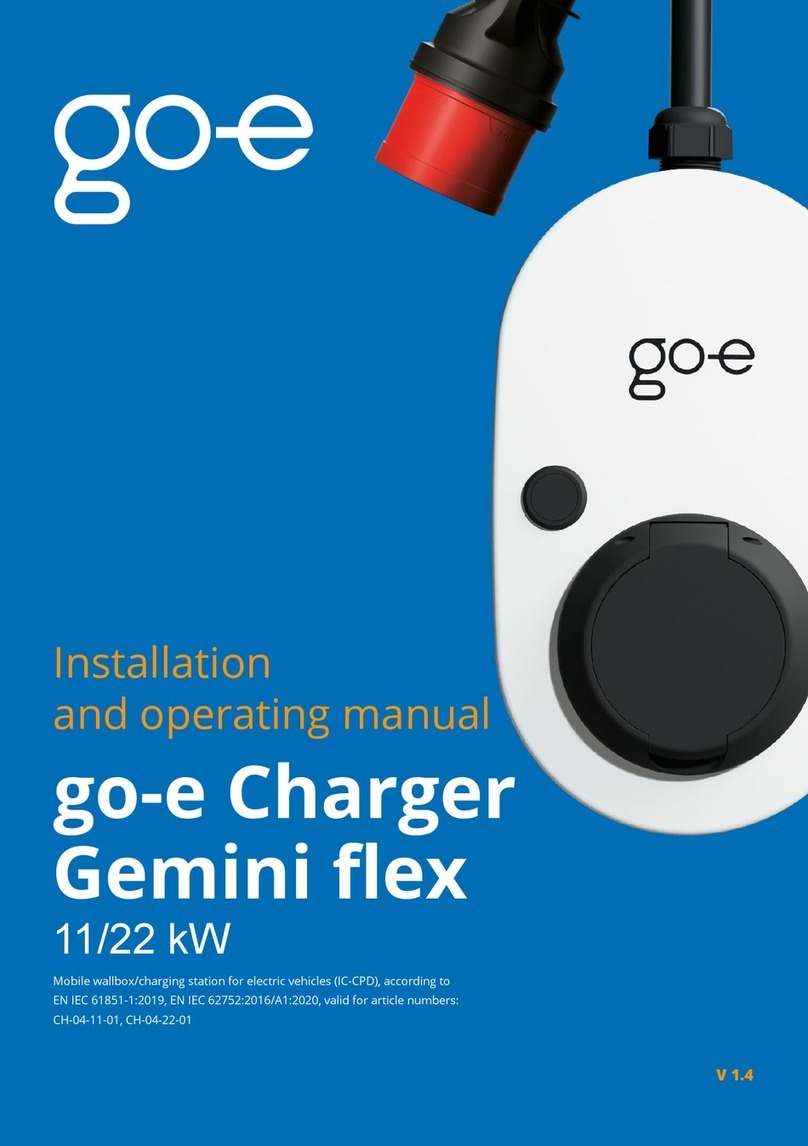
go-e
go-e Gemini flex User manual

go-e
go-e Charger HOME+ User manual
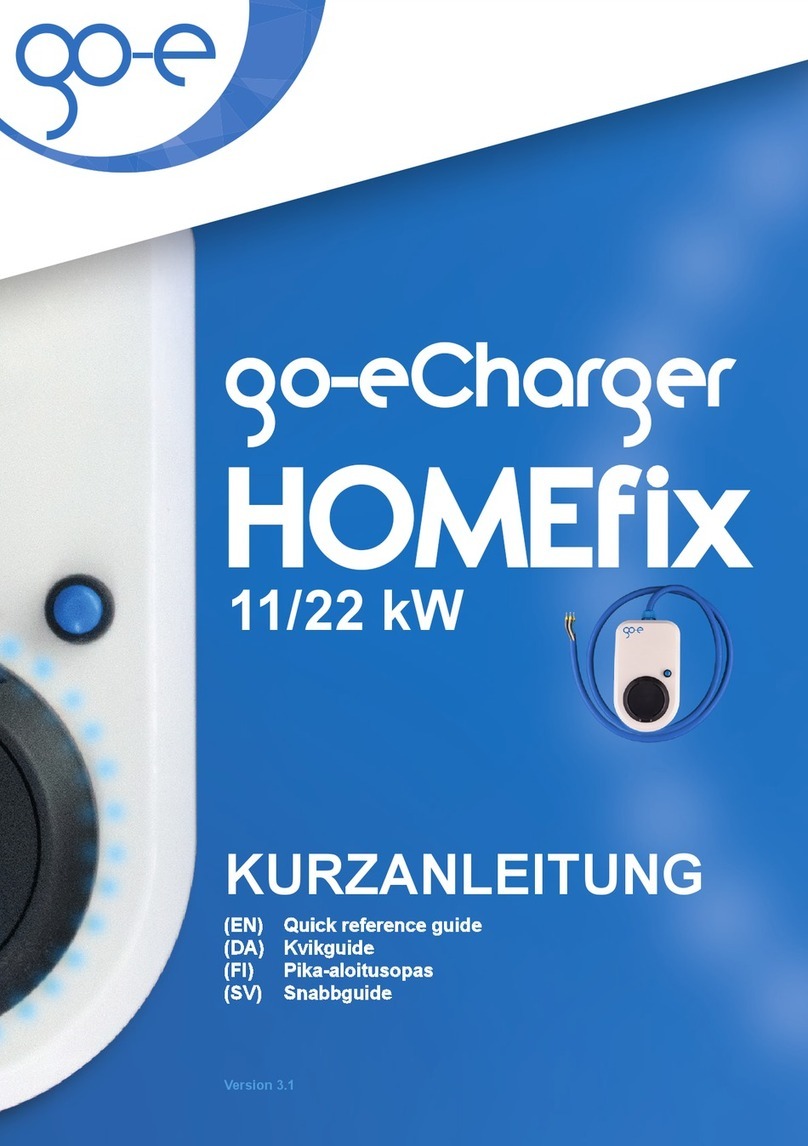
go-e
go-e Charger HOMEfix User manual
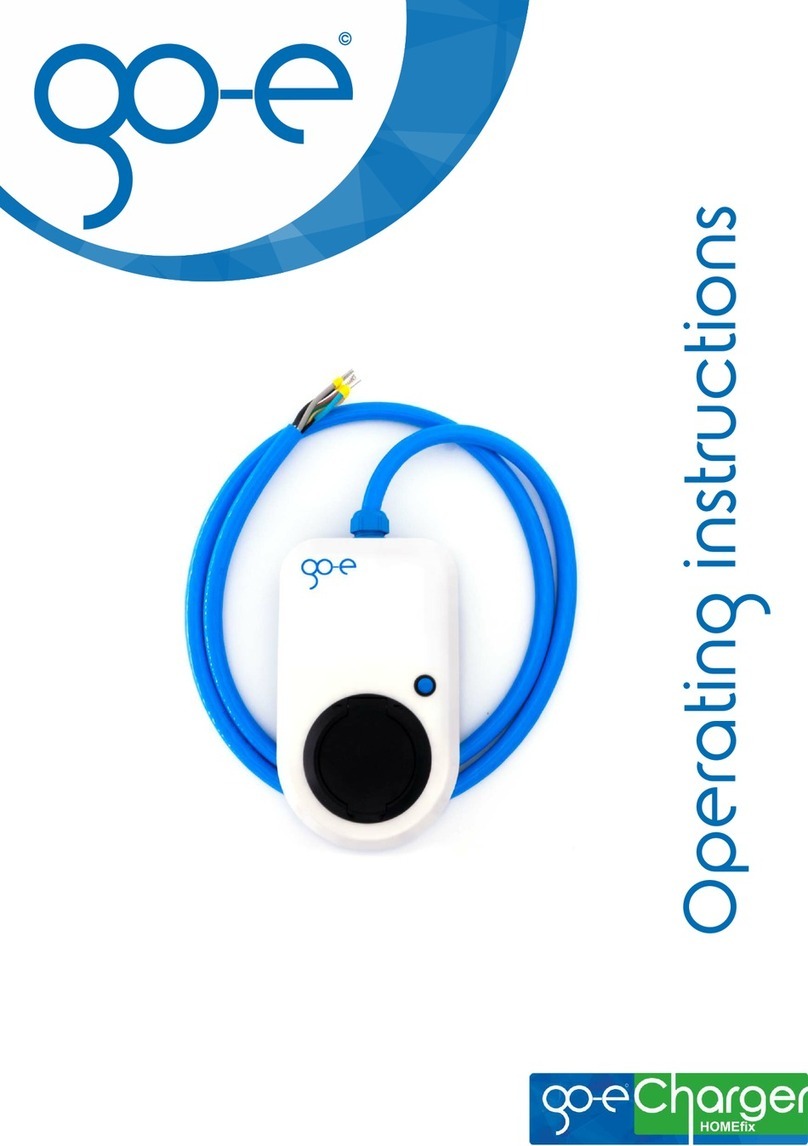
go-e
go-e Charger HOMEfix User manual
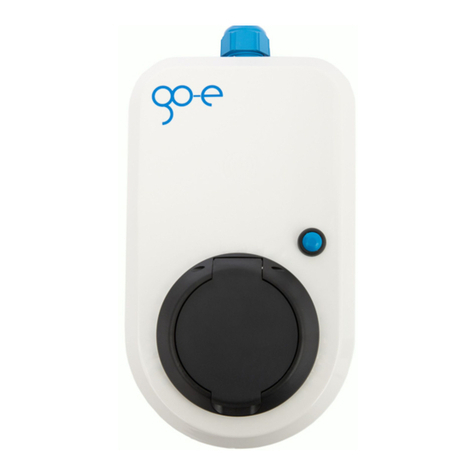
go-e
go-e Charger HOMEfix Manual
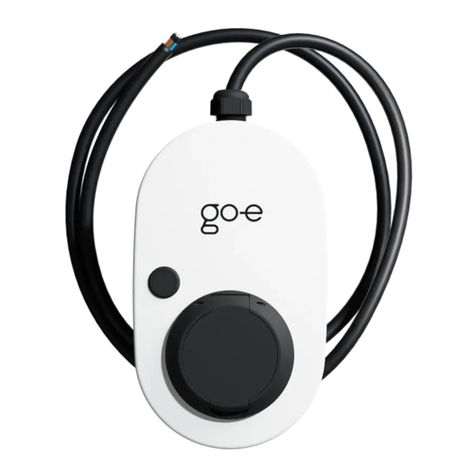
go-e
go-e Gemini Installation guide
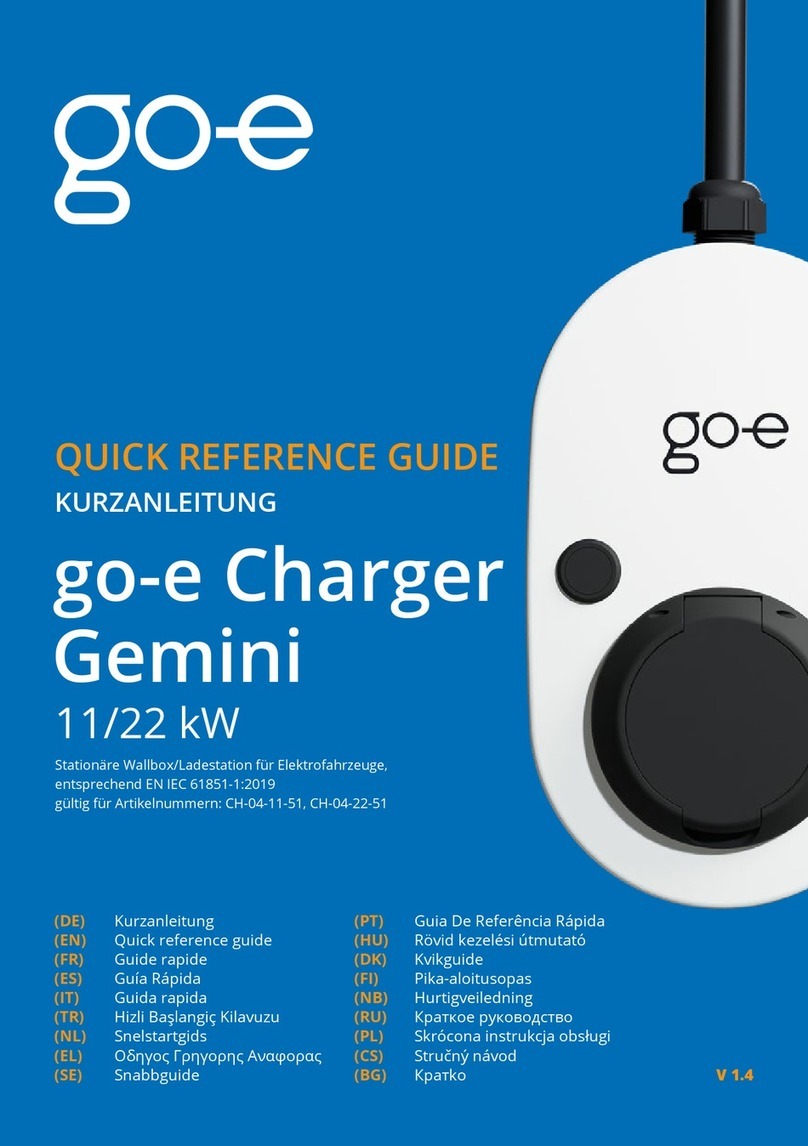
go-e
go-e Charger Gemini 11 kW User manual
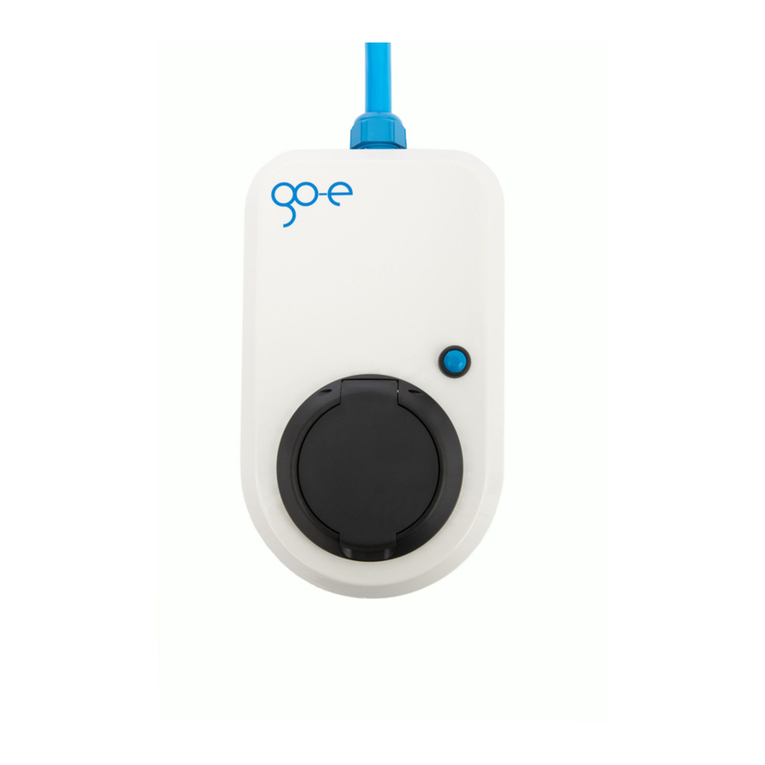
go-e
go-e Charger HOME+ User manual
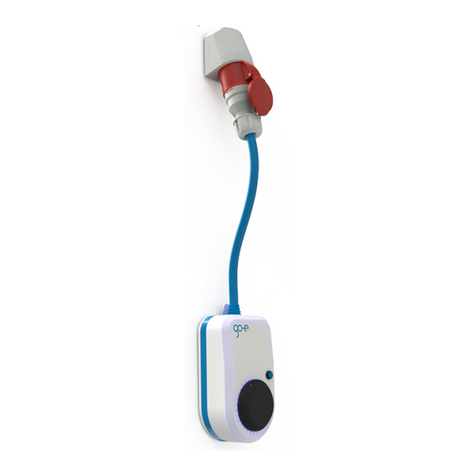
go-e
go-e Charger HOME+ Manual

go-e
go-e Charger HOME+ User manual
